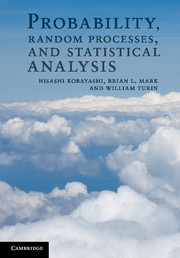 Probability, Random Processes, and Statistical Analysis
Probability, Random Processes, and Statistical Analysis from Part IV - Statistical inference
Published online by Cambridge University Press: 05 June 2012
In this chapter we will study statistical methods to estimate parameters and procedures to test the goodness of fit of a model to the experimental data. We are primarily concerned with computational algorithms for these methods and procedures. The expectation-maximization (EM) algorithm for maximum-likelihood estimation is discussed in detail.
Classical numerical methods for estimation
As we stated earlier, it is often the case that a maximum-likelihood estimate (MLE) cannot be found analytically. Thus, numerical methods for computing the MLE are important. Finding the maximum of a likelihood function is an optimization problem. There are a number of optimization algorithms and software packages. In this and the next sections we will discuss several important methods that are pertinent to maximization of a likelihood function: the method of moments, the minimum χ2method, the minimum Kullback–Leibler divergence method, and the Newton–Raphson algorithm. In Section 19.2 we give a full account of the EM algorithm, because of its rather recent development and its increasing applications in signal processing and other science and engineering fields.
Method of moments
This method is typically used to estimate unknown parameters of a distribution function by equating the sample mean, sample variance, and other higher moments calculated from data to the corresponding moments expressed in the parameters of interest.
To save this book to your Kindle, first ensure [email protected] is added to your Approved Personal Document E-mail List under your Personal Document Settings on the Manage Your Content and Devices page of your Amazon account. Then enter the ‘name’ part of your Kindle email address below. Find out more about saving to your Kindle.
Note you can select to save to either the @free.kindle.com or @kindle.com variations. ‘@free.kindle.com’ emails are free but can only be saved to your device when it is connected to wi-fi. ‘@kindle.com’ emails can be delivered even when you are not connected to wi-fi, but note that service fees apply.
Find out more about the Kindle Personal Document Service.
To save content items to your account, please confirm that you agree to abide by our usage policies. If this is the first time you use this feature, you will be asked to authorise Cambridge Core to connect with your account. Find out more about saving content to Dropbox.
To save content items to your account, please confirm that you agree to abide by our usage policies. If this is the first time you use this feature, you will be asked to authorise Cambridge Core to connect with your account. Find out more about saving content to Google Drive.